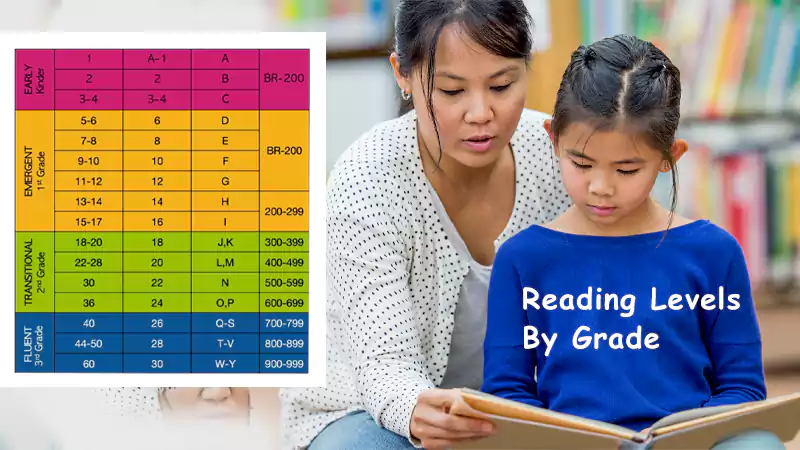
Did your child recently begin going to school? If, yes, you are likely to hear the term “reading level” once your child starts learning to read. Teachers often describe a child’s reading comprehension progress through reading levels by grade.
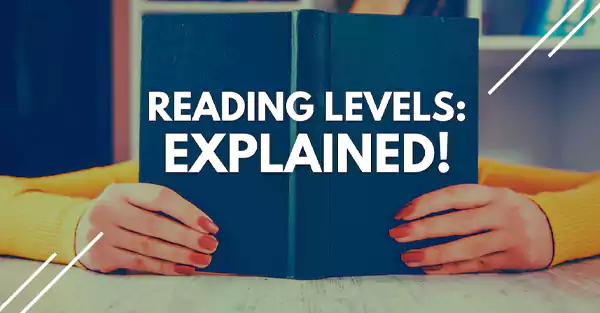
Reading levels are an essential tool for assisting your child as they begin to read. Analysing the studying levels in the early years can shape the child’s growth and understanding. But did you know that matching readers with the right reading level might help even older readers? Yes, you heard it right.
I have created this straightforward guide for teachers and parents so that they can make use of it for different age groups. It also helps teachers to share the progress of children with parents, and set better educational goals for the students. As they talk about what studying levels suit their pupils because we know that this may all be perplexing for parents. Because of the complexity associated with these reading levels.
What is Reading Level?
Are you someone who recently noticed different kinds of grades and numbers mentioned on the backside of the book? Did that intrigue your curiosity to find out what that means? So, to be precise, it indicates the reading grade of the book.
Then, the next question that might have crossed your mind would have been, ‘What is reading level’? These levels are a system for categorising books that can indicate how difficult and/or supportive a text may be.
A thorough method for matching your child’s studying ability with books that they can effectively read and comprehend is by using reading levels. The use of studying levels has become quite common in elementary and middle school settings.
In layman terms, the reading level is an instrument or tool that can be used to assess a student’s reading proficiency. They assess a child’s fluency and comprehension using a range of criteria, including phoneme knowledge, decoding, vocabulary, and other elements.
There are still some important factors to take into account for when and how to use reading levels, even though many instructors, schools, and districts largely rely on them to make instructional decisions.
What are the Four Kinds of Reading Levels?

There are four kinds of reading levels, which are stepping stones in a child’s learning process. Its timely understanding can shape the reading skills for the future. Let’s look at them in detail.
- Elementary reading level
Reading at the elementary school level is considered to be the first level of studying. Many people never rise above this point. The labels “rudimentary reading”, “basic reading”, and “initial reading” also refer to elementary reading levels.
They also serve to imply that once they master it, they have at least attained the beginnings of literacy. One learns the fundamentals of reading, receives fundamental reading instruction, and develops basic reading abilities by mastering this level.
- Inspectional reading level
This second level of reading skills, often known as pre-reading or skimming, separates the barely literate from those who are able to take a more sensible approach.
The more intellectual component of this reading level is the capacity to quickly scan a book for the main points and essential details and decide whether they will interest you.
In fact, skimming has a number of crucial advantages that few are aware of, and it even functions as a substantial and well-known studying technique. Before going through a book, skimming through it can have a significant impact on our understanding and memory.
- Analytical reading level
For someone who merely reads for pleasure, mastering the first two levels would be sufficient; but, in order to use it as a powerful learning tool, one must advance to analytical reading.
Analytical reading is asking yourself key questions as you read, putting yourself in the characters’ situations, comprehending the plot to its core, and examining both the tale itself and the way it is presented.
- Syntopical Reading
The highest degree of reading is called syntopical reading, and it can only be attained by having a deliberate desire to improve as a reader. It is intricate and systematic, calls itself “comparative reading,” and demands a lot of work from the reader.
Syntopical studying offers a level of participation in the reading activity that extends well beyond keeping to a single book, as this alternate name implies. Because all current reading is filtered through the lenses of previously read books, syntopical reading adds an extra layer of attentiveness to the process.
The reader will undoubtedly reap a number of advantages from reaching this level, including considerable improvements in general knowledge and mental wellness.
These are the four reading levels that play a significant role in everyone’s life. Then one question might pop up in your mind, What is the highest reading level you could achieve? Syntopical reading is the highest level that can be attained.
How to Determine a Child’s Reading Levels?
There are numerous ways to evaluate your child’s reading abilities and categorize the books they will read.
The next sections will cover the four most common leveling schemes. For more information on the GRL, DRA, AR, and Lexile level metrics, keep rolling your reading glass.
Lexile Reading Levels
The Lexile Framework is a teaching tool that uses a scale called a Lexile to rank books in terms of their degree of difficulty. Your child does not receive a “Lexile” evaluation; rather, they obtain a Lexile level from a school or state test.

For beginning readers, the Lexile scale goes from less than 0L to more than 2000 L for advanced readers. A reader is classified as a beginner reader if their score is less than 0L. What is the highest reading level for this framework, then? For this structure, it is 2000 L. Ask your child’s teacher if you are unsure of what their Lexile score is.
With the aid of this Framework, it is feasible to match readers with content that will improve their vocabulary, comprehension, and fluency—three crucial components of effective reading.
Developmental Reading Assessment Levels
A professional or a teacher will administer the DRA test. The system truly starts with A, but after that, all other levels are numbered and books are matched to the kid on a numerical reading scale from 1 to 80.

Numerous factors are taken into consideration to determine reading level, including:
- Reading fluency
- Phonemic awareness
- Prosody
- Pronunciation
- Miscues
- Self-corrections
- Reading accuracy
- Average reading speed
- Reading comprehension
These are some factors that are considered for analyzing the level of study among students.
ATOS / AR Reading Levels
The Accelerated Reader (AR) level of your child is determined by a computer test. Your youngster reads a book of their choice and then completes an online test to gauge their level of reading comprehension and receive points.

The next question will be more difficult if they respond properly to the previous one. The subsequent question will be more straightforward if they respond incorrectly to the first one.
The AR reading levels are broken down into numerical ranges that closely match projected grade levels. In the fourth month of the academic year, a second-grader will typically be studying books at level 2.4. The average level for a fourth grader in the first month of the school year is 4.1, and so forth.
Guided Reading Levels
The method is created by Irene Fountas and Gay Su Pinnell serves as the foundation for guided reading levels or GRL. For this reason, GRL is also frequently referred to as Fountas & Pinnell.
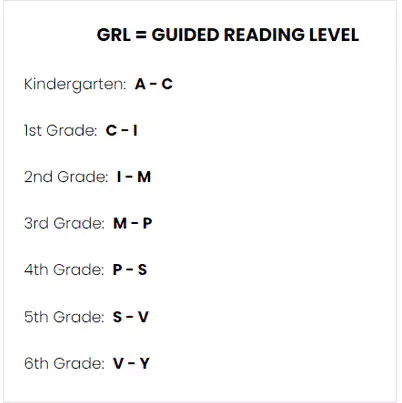
The guided framework takes into account the following ten features when describing reading levels:
- Genre
- Text Structure
- Content
- Themes and Ideas
- Language and Literacy Features
- Sentence Complexity
- Vocabulary
- Word repetition and form
- Illustrations
- Book and Print Features
Children read aloud to their teacher one-on-one from a “benchmark” book that is regarded as appropriate for their grade level in order to assess reading levels using the GRL.
Guided reading levels by grade system, this approach alphabetically groups reading levels from A to Z. A being the earliest reader and Z being the most advanced.
The teacher will take notes on any words that are missed while going through these books and pose comprehension queries. This helps teachers determine the right reading level to which the child belongs.
How to Check Reading Levels at Home?
Geoffrey Holder rightly said,“ Education begins at home. You can’t blame the school for not putting into your child what you don’t put into him”.
This necessitates your reading grade at home. Try the five-finger rule if you’re seeking a method other than those mentioned above to determine your child’s reading ability.

This is how it goes: Your child turns to the first page of a book. As they read the page, they raise a finger for each unfamiliar or difficult-to-pronounce word. The number of finders they are holding up by the page’s finish indicates the book’s level: 0 to 1 finger. It’s too simple.
Although this is a useful tactic, you should feel free to let your child attempt a book and gauge how well he or she reads. There is nothing wrong with reading books that are too easy, and books that are on a high school reading level. Most kids will be able to tell whether a book is too challenging.
A child may occasionally show interest in a book that is a little challenging for them. We advise you to read aloud to your youngster if this occurs. Alternating between pages, paragraphs, or sentences allows you to read aloud.
Tip: To make it simple for you to select the ideal book for your beginning reader, most libraries and bookshops have books categorized by reading level. You might also ask the store staff by presenting them with a book your kid likes.
Why is Determining Reading Level Important?
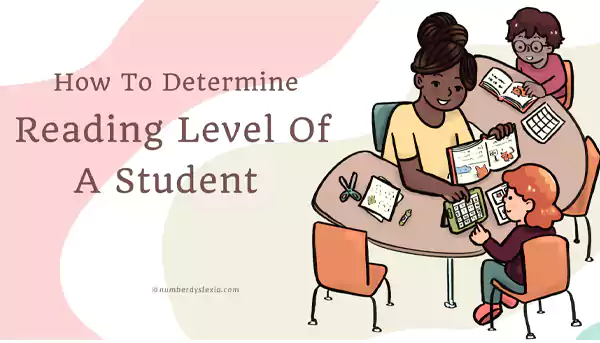
Knowing your child’s reading ability can help you select books that are suitable for independent reading while still being hard enough to promote growth. A reading level should not test only books but the reading skills of the child.
You can use the this classification as a practical aid while doing online or library searches. Additionally, when you give your child books that are appropriate for them, you excite them and boost their self-esteem, which can result in a lifelong love of learning and reading!
A reading assessment only informs teachers and parents of the child’s current proficiency and potential, while also offering a second, more precise indicator of the degree of book difficulty that will be to your child’s advantage.
When are These Assessments Administered?
Many guardians and teachers often find it confusing when a child’s reading level assessment should be administered. Are you also one of them?
Relax here, I have summarized for you when you should administer a child’s progress in reading. Along with that, I have stated when schools usually administer a child’s reading level.
- In the case of schools, in the autumn, winter, and spring of each academic year, reading exams are usually given two to three times to students. Learning to read well takes practice. As children develop and mature, their reading levels will fluctuate regularly. These tests enable teachers to gauge the reading proficiency of their students.
- As a parent, you should assess your child’s level of reading every three months by giving them reading tests that test their vocabulary and reading levels.
For some children, reading proficiency varies greatly from year to year and month to month. These tests help the teachers alter their instruction and plan lessons accordingly.
What are Reading Level Scores Used for?
Mortimer Adler published How To Read A Book in 1940, which states how to read a book in order to learn the most out of it. He also highlighted the role that grading and scores play in improving people’s reading skills.

Reading proficiency levels can inspire students and enable them to receive individualized teaching in reading classes. The assessment results at the moment of reading aloud do not limit a student’s prospects or define them.
The level of a student will assist teachers in identifying pupils’ reading strengths and weaknesses so that reading education can be tailored to meet those needs.
How do I Know if a Book is Appropriate for My Child’s Reading Level?
Finding a kid-friendly book that they can read independently for themselves could be as challenging as remembering all the ingredients to a bakery shop pie order!
Reading levels are numerical ratings given to books, but parents and kids may have trouble comprehending them. It can be much harder to locate the books that correspond to these levels.
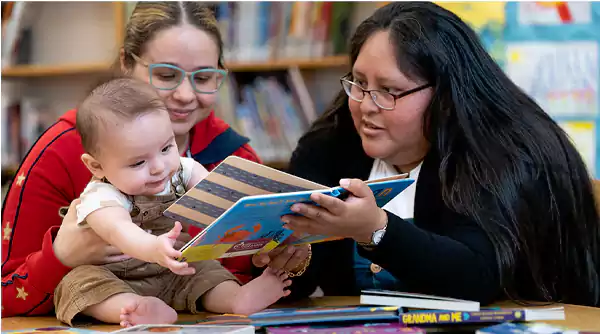
Your child’s teacher is a good place to start. They will be qualified to advise you on selecting the best books for your child. You may also look at most books online to determine their reading level.
Additionally, some publishers label books in stages with suggested ages and/or reading levels by grade for beginning readers. You can also get in touch with your neighborhood bookstore or library if you’re homeschooling.
They frequently know about this subject because they live surrounded by books every day, and they might be able to recommend a few novels that are appropriate for your child’s reading level.
Reading Levels Synopsis
All the different types of reading levels can be overwhelming. Learning to read can be a rewarding journey, but there are times when it’s difficult. Reading should be enjoyable, not a burden.
Reading levels are currently used in several classrooms around the nation and may be seen in bookshops and on scholastic order forms. To make it more effective in classrooms, collaborative strategic reading could be used in the classroom for reading assessments.
Although there are many other reading leveling systems, reading levels denoted by the letters A–Z are frequently employed. Both the teacher’s and parent’s alliance with each other could help in analyzing the child’s reading levels. This will help them to decide on a further plan of action.
Sources: